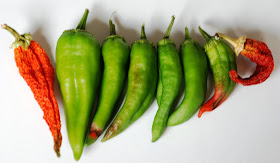Zone 9 in July
July and August are the hottest months here in Houston. Daily average temperatures top 95° and the low is rarely below 70°. It takes a hurricane or tropical storm, like Hurricane Alex that is fast approaching Texas, to cool things off here. This extreme heat is hard on most vegetable plants with a few notable exceptions. We've already recommended eggplant and lima beans, both of which are thriving in our garden right now. Another vegetable that loves our July weather is chile peppers.
Chile peppers are in the eggplant and tomato family, and are highly productive when it heats up outside. We have had excellent results with Anaheim (above) and Jalapeno (below) as well as Cayenne, Poblano, and Serrano chiles. The plants need little care or attention, and will produce small flowers that are attractive in the garden. In fact, ornamental pepper plants are quite popular here in Houston even though the fruits are inedible. Why not grow the real thing instead?
Pepper plants are easy to start from seed. The seeds are quite small, so we prefer to start these in pots rather than direct sowing. Transplant when the seedlings have four or more leaves, keeping well watered before and after transplanting. Try to shade transplants during the hottest part of the day to avoid scalding and killing the plants. And don't go overboard with seedlings. Only a few plants are enough for the whole family because the plants are quite productive, and fresh chiles are extremely potent. If you haven't already started your seedlings, it's not too late, although next year we suggest you get an earlier start. We've been harvesting peppers for months.
Chile peppers can be used in any number of tacos, quesadillas and salsas. We often use them to season pasta and vegetable dishes as well. And any extra peppers are easy to dry and save for later.
We were still using dried cayenne peppers from last summer almost a year later. We dry ours indoors because the humid weather here tends to rot everything that is left outside. In more arid climates, it is recommended that the peppers be left to hang outside in a sheltered spot until dry.
Other Posts in the Get Growing Series
Determining Your Gardening Zone and Growing Peas
Garden Planning, Planting Methods and Seed Selection
Growing Lettuce
Starting Seeds Indoors
Growing Tomatoes
Compost: What is It, How to Make it, How to Use It
Growing Snap Beans
Spinach, Row Covers and Peas
Growing Eggplant
Growing Lima Beans
Determining Your Gardening Zone and Growing Peas
Garden Planning, Planting Methods and Seed Selection
Growing Lettuce
Starting Seeds Indoors
Growing Tomatoes
Compost: What is It, How to Make it, How to Use It
Growing Snap Beans
Spinach, Row Covers and Peas
Growing Eggplant






Great series - thanks! I found you through Daphne's Dandelions. It's great for me that you and I are in the same zone - I'm in Central Florida.
ReplyDeletebeautiful pics of the chillies :)
ReplyDeleteInteresting blog. It would be great if you can provide more details about it. Thanks you.
ReplyDeleteOrganic Gardens